A STUDY ON THE MANAGEMENT OF THE NEW GENERATION OF STAFF TURNOVER IN STATE-OWNED COMMERCIAL BANKS: A CASE STUDY OF X BANK
Keywords:
State-owned Commercial Banks; The New Generation of Employees; Leave ManagementAbstract
After China’s financial industry having entered into rapid development with China’s accession to the WTO, joint-stock commercial banks have also risen in various places, and the number of branches established by foreign banks in China has gradually increased, showing that they were once monopolized as China’s financial industry continues to reform and develop. The status of the four state-owned joint-stock commercial banks has been shaken. Foreign banks and joint-stock commercial banks have their own strategies in order to attract the new generation of employees who are the core force of enterprise development. However, the issue of the new generation of employees leaving in state-owned commercial banks has not been taken seriously.
The concept of the new generation of employees is very broad and belongs to the definition of a group. No matter how Chinese and foreign scholars define this group, this group is already the core force of enterprise development today. They have several characteristics that are different from those born in the old generation, such as more independent thinking and pursuit of democratization. The learning ability is very strong; the level of education is higher; the innovation ability is stronger; and so on.
However, the new generation of employees has a major problem that cannot be ignored in the banking industry, and that is "resignation." The business scope of state-owned commercial banks accounts for a very large proportion of the economic field, which is the foundation of a country’s financial system. The phenomenon of the loss of the core force for development will obviously have a huge impact on the stable operation of state-owned commercial banks and is not conducive to state-owned commercial banks. The continuous improvement of commercial banks' operating capabilities will also have a negative impact on multi-charging.
This paper will focus on the definition and characteristics of the new generation of employees, using Bank X as an example, the current development of Bank X and the current development of the new generation of Bank X employees, and the negative impact of the new generation of Bank X employees after their departure. A comprehensive analysis of the reasons for their resignation was conducted, and on this basis, the countermeasures were put forward to reduce the turnover rate of the new generation of employees in state-owned commercial banks, hoping to provide a proper resignation management plan, so that Bank X can proceed from its own reality and strengthen the state-owned company. The commercial bank management and construction adopt corresponding strategies to reduce the turnover rate of the new generation of employees and stabilize the countermeasures of talent team building.
References
Chen Liwei. (2016). Reasons for the turnover of new generation employees in Wenzhou Branch of Bank S and countermeasures. China Business & Trade, (30):71-73.
Ji Nana. (2016). A study on the turnover motivation of new generation employees in commercial banks in small and medium-sized cities. Modern Economic Information, (4):45.
Li Yongzhou, Yi Qian, & Yang Jingning. (2016). The influence of positive communication environment, organizational identification for contextual performance of new generation of employees. Human Resource Development of China, (23): 23-31.
Liu Ting. (2014). Analysis and countermeasures for the turnover of counter staff of Bank A in Suzhou. Suzhou: Suzhou University.
Peng Cheng, & Guo Lifang. (2015). Research on high-performance human resource management practice for the millennials. Reform of Economic System, (06):124-129.
Tan Jianwei, Shi Jiaojiao, & Sun Lilu. (2018). The influence of emotional labor strategies on the turnover intention of the millennial generation: the mediation effect of job embeddedness. Journal of Chongqing University of Technology (Social Science), 32(02).71-77+136.
Xu Xuejun. (2012). Performance Appraisal and Remuneration of Commercial Banks: Theories and Methods. Shanghai: Shanghai University of Finance and Economics Press.
Zhao Xiang. (2016). A brief talk on human resource management of commercial banks in future cities. Theory Circle, 16 (04): 218-219.
Zhao Zhongjun, & Liu Yajun. (2018). Research orientation and trend of new generation employees: a bibliometric analysis based on core journals. Journal of Inner Mongolia Agricultural University (Social Science Edition), 20(01):5-84.




